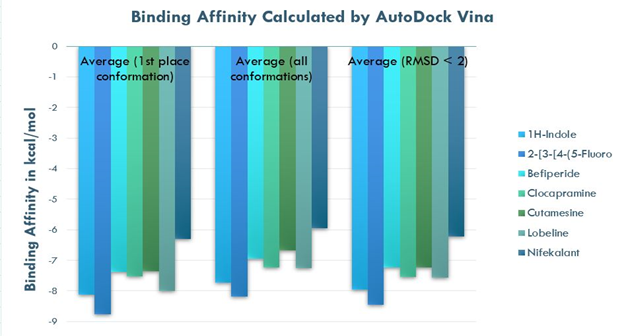Short abstract
This project aimed to predict an antiviral drug that will bind tightly to the ebolavirus’s surface glycoprotein to inhibit the entrance of the ebolavirus into human cells. Molecules were screened through successive in silico filters to test for ADMET properties and affinity to the ebolavirus glycoprotein binding site. The final molecule 2-[3-[4-(5-Fluoro-1H-indol-3-yl)-3,6-dihydro-2H-pyridin-1-yl]propyl]isoindole-1,3-dione had the highest binding affinity to the glycoprotein and was predicted to be safe and orally bioavailable.
Introduction
Ebola virus disease causes a deadly hemorrhagic fever. Current Ebola treatments are expensive and often inaccessible, as they need to be taken intravenously, which is an issue in low-resource countries susceptible to outbreaks. An orally taken small molecule drug would be cheaper to produce and more accessible than current treatments. The goal of this project is to use computational drug discovery methods to predict an antiviral drug that will inhibit the function of the Ebola virus surface glycoprotein, while also being nontoxic and orally bioavailable.
Experimental details
First, the structure of the ebolavirus glycoprotein from the Protein Data Bank was prepared by identifying the best binding hot spots with the FTMap and FTSite programs. Then molecules downloaded from the ZINC15 database were screened through Lipinski's Rule of 5 for drug-like properties. Those that passed were put to a preliminary docking test in the CLC Drug Discovery Workbench and ranked according to their binding affinity. The top 100 molecules were ranked according to their safety and oral bioavailability using the admetSAR 2.0 webtool. Lastly, the top seven molecules were put through a comprehensive docking test using AutoDock Vina to see which one has the strongest affinity for the glycoprotein binding site.
Results and discussion

Figure 1: The binding affinities of the top seven molecules as calculated by using the molecular docking program AutoDock Vina.

Figure 2: The CLC score and admetSAR 2.0 toxicity and oral bioavailability data for the top seven molecules
The molecule with the highest binding affinity to the Ebola virus glycoprotein is 2-[3-[4-(5-Fluoro-1H-indol-3-yl)-3,6-dihydro-2H-pyridin-1-yl]propyl]isoindole-1,3-dione (hereafter referred to as 2-Fluoro) with an average first place binding energy of -8.76 kcal/mol. A single factor ANOVA test showed the differences between the means of the affinities of the seven molecules were statistically significant (p<0.001) and a t-test of the top two molecules confirmed that 2-Fluoro had a significantly stronger affinity (p<0.001).
Conclusion
In the attempt to discover a new orally bioavailable drug to bind to the Ebola virus glycoprotein, this molecular docking study came upon a strongly binding and orally bioavailable drug candidate, 2-Fluoro. Experimental research is necessary to determine if the molecule inhibits the ebolavirus, as this project only looks at binding affinity of various molecules and does not prove that this will prevent the Ebola virus from entering a human cell. Additionally, the properties tested for safety and oral bioavailability are computer predictions and may not account for all aspects of toxicity. The next step is to recreate this process using a larger dataset of molecules and more binding sites to find more drug candidates for experimental testing in a lab setting.
Acknowledgements
I would like to thank Lauriann Carbajal for introducing me to all the possibilities in high school science research and for guiding me through the process.
References
Ebola Treatment. (2019, November 05). Retrieved November 06, 2020, from https://www.cdc.gov/vhf/ebola/treatment/index.html
Khataby, K., Kasmi, Y., Hammou, R. A., Laasri, F. E., Boughribi, S., & Ennaji, M. (2016, August 10). Ebola Virus's Glycoproteins and Entry Mechanism. Retrieved November 06, 2020, from https://www.intechopen.com/books/ebola/ebola-virus-s-glycoproteins-and-entry-mechanism
Lee, J., & Saphire, E. (2009). Ebolavirus glycoprotein structure and mechanism of entry. Retrieved November 06, 2020, from https://www.ncbi.nlm.nih.gov/pmc/articles/PMC2829775/
PDB101: Molecule of the Month: Ebola Virus Proteins. (n.d.). Retrieved November 06, 2020, from https://pdb101.rcsb.org/motm/178
- Trott, A. J. Olson, AutoDock Vina: improving the speed and accuracy of docking with a new scoring function, efficient optimization and multithreading, Journal of Computational Chemistry 31 (2010) 455-461
Kozakov, D., Grove, L. E., Hall, D. R., Bohnuud, T., Mottarella, S. E., Luo, L., . . . Vajda, S. (2015). The FTMap family of web servers for determining and characterizing ligand-binding hot spots of proteins. Nature Protocols, 10(5), 733-755. doi:10.1038/nprot.2015.043
Lipinski, C. A., Lombardo, F., Dominy, B. W., & Feeney, P. J. (1997). Experimental and computational approaches to estimate solubility and permeability in drug discovery and development settings. Advanced Drug Delivery Reviews, 23(1-3), 3-25. doi:10.1016/s0169-409x(96)00423-1
QIAGEN CLC Main Workbench: QIAGEN Digital Insights. (2020, June 29). Retrieved December 10, 2020, from https://digitalinsights.qiagen.com/products-overview/discovery-insights-portfolio/analysis-and-visualization/qiagen-clc-main-workbench/
Yang, H., Lou, C., Sun, L., Li, J., Cai, Y., Wang, Z., . . . Tang, Y. (2018). AdmetSAR 2.0: Web-service for prediction and optimization of chemical ADMET properties. Bioinformatics, 35(6), 1067-1069. doi:10.1093/bioinformatics/bty707





